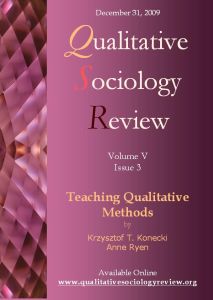What do we study studying body? Researcher’s attempts to embodiment research
DOI:
https://doi.org/10.18778/1733-8077.5.3.07Keywords:
Grounded Theory Methodology, Interview, Observation, Visual Data Analysis, Embodiment, DanceAbstract
The article presents researcher’s attempts, methodological problems and queries in embodiment research during a Grounded Theory Methodology based study on social world of ballroom dancers. The research has been conducted among ballroom dancers, flamenco dancers, belly dancers, dance instructors, choreographers and judges. One of the aspects of the research is social construction of embodiment. In the article I will present techniques and methods of research such as autoetnography, interview, observation, photo and video analysis as well as kind of results they may give and what is really studied when using these methods. I will also present how one experiences his/her body in this group. I will try to answer a question: what is the real result of researcher’s attempts in embodiment study in sociology; do we really study body, or its social practices, socially constructed individual experience; how deeply can we make the research when our object (somebody else’s body) is not entirely intersubjectively available for our recognition.
Downloads
References
Bittnerowna, Barbara (2004) Nie tylko o tańcu. Warszawa: Pruszyński i Spółka.(Not only about dance).
Google Scholar
Charmaz, Kathy (2006) Constructing Grounded Theory. A Practical Guide Through Qualitative Analysis. London, Sage, New Delhi: Sage Publications.
Google Scholar
Coenen, Herman (1989) “Cielesność za Ŝycie społeczne. O podstawowym problemie socjologii fenomenologicznej”. Pp 255-287 in Fenomenologia i socjologia. Zbiór tekstów edited by Krasnodębski, Zdzisław. Warszawa: PWN.
Google Scholar
Desmond, Jane C. (1997) “Embodying difference: issues in dance and cultural studies” in Meaning in Motion. New Cultural Studies of Dance edited by Desmond, Jane C. Durham, London: Duke University Press.
Google Scholar
DOI: https://doi.org/10.2307/j.ctv11sn2b4
Dietz, Mary Lorenz (1994) “On your toes: dancing your way into the ballet world”. Pp 66-84 in Ethnography as Human Lived Experience edited by Dietz, Mary Lorenz; Prus, Robert and Shaffir William. Toronto: Copp Clark Longman Ltd.
Google Scholar
Foster, Susan Leigh (1997) “Dancing bodies”. Pp 235-257 in Meaning in Motion. New Cultural Studies of Dance edited by Desmond, Jane C. Durham, London: Duke University Press.
Google Scholar
DOI: https://doi.org/10.1215/9780822397281-013
Goffman, Erving (2000) Człowiek w teatrze Ŝycia codziennego. Warszawa: Wydawnictwo KR. (Polish translation of the Presentation of Self in Everyday Life).
Google Scholar
Goffman, Erving (2006) Rytuał interakcyjny. Warszawa: PWN. (Polish translation of the Interaction Ritual: Essays on Face-to-Face).
Google Scholar
Grau, Andree (2005) “When the landscape becomes flesh: an investigation into body boundaries with special reference to Tiwi dance and Western classical ballet”. Pp 141-163 in Body and Society vol. 11.
Google Scholar
DOI: https://doi.org/10.1177/1357034X05058024
Hammarsley, Martyn and Atkinson, Paul (2000) Metody badań terenowych. Poznań: Zysk i S-ka (Polish translation of the Principles In Practice).
Google Scholar
Hanna,Judith Lynne (1988) Dance, sex and society. Signs of dominance, defiance, and desire. Chicago, London: The University of Chicago Press.
Google Scholar
Hughes, Everett E. (1997) “Careers”. Qualitative Sociology, vol. 20 No 3.
Google Scholar
DOI: https://doi.org/10.1023/A:1024731416961
Konecki, Krzysztof T. (2000) Studia z metodologii badan jakościowych. Teoria ugruntowana. Warszawa: Wydawnictwo Naukowe PWN.
Google Scholar
Konecki, Krzysztof T. (2005) Wizualne wyobrażenia. Główne strategie badawcze w socjologii wizualnej a metodologia teorii ugruntowanej. Pp. 42-63 in Przegląd Socjologii Jakościowej, Vol I, Issue 2. Retrieved November, 2009 www.qualitativesociologyreview.org
Google Scholar
DOI: https://doi.org/10.18778/1733-8069.1.1.04
Kvale, Steinar (2004) InterViews. Wprowadzenie do jakościowego wywiadu badawczego. Bialystok: Trans Humana. (Polish translation of the InterViews. An introduction to qualitative research interviewing).
Google Scholar
Merleau-Ponty, Maurice (2001) Fenomenologia percepcji. Warszawa: Fundacja Aletheia. (Phenomenology of perception).
Google Scholar
DOI: https://doi.org/10.4324/9780203994610
Schutz, Alfred (2008) O wielości światów. Zakład Wydawniczy NOMOS, Kraków.
Google Scholar
Strauss, Anselm and Corbin, Juliet (1990) Basics of Qualitative Research. Grounded Theory Procedures and Techniques. Newbury Park, London, New Delhi: Sage Publications.
Google Scholar
Suchar, Charles S. (1997) Grounding Visual Sociology Research In Shooting Scripts. Qualitative Sociology, vol. 20, no. 1.
Google Scholar
DOI: https://doi.org/10.1023/A:1024712230783
The Cambridge Dictionary of Philosophy, (1999) Second Edition General Editor: Robert Audi. Cambridge University Press, Cambridge, Science Press.
Google Scholar
Turner, Bryan S. (2007) “The constructed body”. Pp 493-511 in Handbook of Constructionist Research edited by Holstein, James A. And Gubrium, Jaber F. New York, London: The Guilford Press.
Google Scholar
Turner, Bryan S. and Wainwright, Steven P. (2003) “Corps de ballet: the case of injured ballet dancer”. Pp. 269-288 in Sociology of Health and Illness vol. 25 no. 4 .
Google Scholar
DOI: https://doi.org/10.1111/1467-9566.00347
Turner, Bryan S. and Wainwright, Steven P. (2004) “Epiphanies of embodiment: injury, identity and the balletic body” Pp. 311-337 in Qualitative Research vol. 4(3). SAGE Publications: London, Thousand Oaks, New Delhi.
Google Scholar
DOI: https://doi.org/10.1177/1468794104047232
Wainwright, Steven P.; Williams, Clare and Turner, Bryan S. (2006) “Varieties of habitus and embodiment of ballet”. Pp. 535-558 in Qualitative Research vol. 6(4).SAGE Publications: London, Thousand Oaks, New Delhi.
Google Scholar
DOI: https://doi.org/10.1177/1468794106068023
Wall, Sarah (2008) “Easier said, than done: writing an autoethnography”. International Journal of Qualitative Methods 7(1). Retrieved 10 November 2009 http://ejournals.library.ualberta.ca/index.php/IJQM/article/view/1621/1144
Google Scholar
DOI: https://doi.org/10.1177/160940690800700103
Downloads
Published
How to Cite
Issue
Section
License

This work is licensed under a Creative Commons Attribution-NonCommercial-NoDerivatives 4.0 International License.











